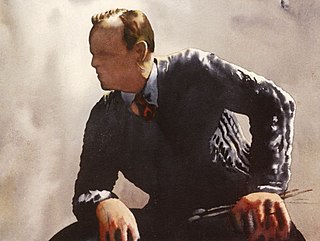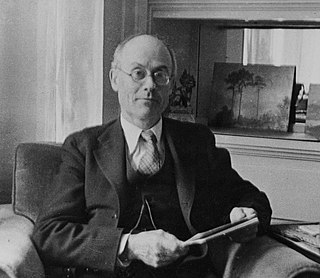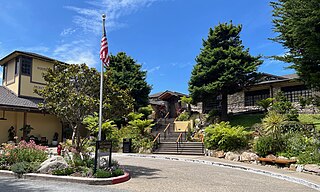
Carmel-by-the-Sea, commonly known simply as Carmel, is a city in Monterey County, California, located on the Central Coast of California. As of the 2020 census, the town had a total population of 3,220, down from 3,722 at the 2010 census. Situated on the Monterey Peninsula, Carmel is a popular tourist destination, known for its natural scenery and rich artistic history.

Carmel Highlands is an unincorporated community in Monterey County, California, United States. It is 3.5 miles (5.6 km) south of Carmel-by-the-Sea, at an elevation of 318 feet. Carmel Highlands is just south of the Point Lobos State Reserve, and serves as the northern gateway of the Big Sur coastline along California State Route 1. Carmel Highlands was laid out in 1916 by developers Frank Hubbard Powers and James Franklin Devendorf and the Carmel Development Company.

Robert Stanton (1900-1983) was an American architect. A resident of Carmel-by-the-Sea, California, he practiced primarily in the central California coastal region, and was responsible for a variety of eclectic buildings, most notably the Monterey County Court House and the King City Joint Union High School Auditorium, both listed on the National Register of Historic Places. He worked closely with sculptor Joseph Jacinto Mora on several of his projects.

Paul Lingenbrink Whitman was an American artist who played an active role in the art community of the Monterey Peninsula for 24 years. His works are in the art collections of the National Gallery of Art, the Monterey Museum of Art and the Fine Arts Museums of San Francisco. Whitman was one of the original members of the Carmel Art Association. He worked in a variety of media that included etching, charcoal drawing, watercolor, oil, lithography, and sculpture.

Mrs. Clinton Walker House, also known as Cabin on the Rocks, is located on Carmel Point, near Carmel-by-the-Sea, California. The house was designed by Frank Lloyd Wright in 1948 and completed in 1952 for Mrs. Clinton "Della" Walker of Pebble Beach. It was listed on the National Register of Historic Places on November 17, 1977.

Carmel Woods is an unincorporated community in Monterey County, California, United States. It is located adjoining the northern city limits of Carmel-by-the-Sea and adjacent to Pebble Beach. Carmel Woods was laid out in 1922 by developer Samuel F. B. Morse (1885-1969). It included a 25-acre (0.10 km2) subdivision with 119 building lots. Carmel Woods was one of three major land developments adjacent to the Carmel city limits between 1922 and 1925. The other two were the Hatton Fields, a 233 acres (94 ha) between the eastern town limit and Highway 1, and the Walker Tract to the south, which was 216 acres (87 ha) of the Martin Ranch called The Point.

Outlands in the Eighty Acres, also known as Flanders Mansion is an 8,000-square-foot Tudor Revival house. It is significant as a work of architect Henry Higby Gutterson, and for its innovative construction with light grey interlocking Precast concrete blocks. It is one of the earliest architect designed residences in Carmel-by-the-Sea, and the only known example of work by Gutterson in the region. It is located within the Mission Trail Nature Preserve in Carmel-by-the-Sea, California. It was listed on the National Register of Historic Places on March 23, 1989.

James Franklin Devendorf, was a pioneer real estate developer and philanthropist. Devendorf and attorney Frank Hubbard Powers (1864-1921), founded the Carmel Development Company in 1902. He became the "Father" of an artists and writers' colony that became Carmel-by-the-Sea, California, which included the Carmel Highlands, California. Devendorf spent the next 30 years of his life developing Carmel and the Carmel Highlands into a community of painters, writers, and musicians.

Frank Hubbard Powers, served in the California State Assembly for the 41st district from 1895 to 1897. He was a San Francisco attorney for Heller & Powers. He and real estate developer James Franklin Devendorf (1856-1934), founded the Carmel Development Company in 1902. They established an art colony that became Carmel-by-the-Sea, California, which included the Carmel Highlands, California.

Santiago Jacob Duckworth, known locally as S. J. Duckworth, served in the California State Assembly for the 61st district from 1893 to 1895. He was as an early Monterey pioneer businessman, real estate developer, and visionary of the short-lived Carmel City. In 1889, he wanted to build a Catholic summer resort, bought the rights to develop the area, filed a subdivision map, and started selling lots. After an unsuccessful undertaking, he sold the property to James Franklin Devendorf in 1902, who went on to found the Carmel Development Company and Carmel-by-the-Sea, and the Carmel Highlands in California, United States. Duckworth helped shape the early development of Carmel, bringing the first major developers and builders, and attracting some of the first residents.

Honoré Escolle, was as a French businessman from Monterey, California. He was an early pioneer who became a significant landholder in Monterey County. In 1878, he purchased 1,400 unsettled acres (570 ha) acres of the Sanchez's ranch near Gonzales, California. In the late 1880s, he sold 324 barren acres (131 ha) to Santiago J. Duckworth to build a Catholic Summer resort. This land later became Carmel-by-the-Sea, California

Herbert "Bert" Heron was an American writer, actor, and poet. Heron is best known for founding the Forest Theater in 1910. He was the former mayor of Carmel-by-the-Sea, California, for two terms in the 1920s. He lived in Carmel for 62 years.
The following is a timeline of the history of Carmel-by-the-Sea, California, United States.

Louis Stanislaus Slevin, was an American photographer, known for his black-and-white images of the Monterey Peninsula. He was a pioneer in the early days of Carmel-by-the-Sea, California, the first to open a general merchandise store in 1905, the first postmaster, first express agent, and first city treasurer. His photographs of Carmel from 1903 to 1835 are recognized as a record of Carmel's past. His photo collection is housed at the Bancroft Library, University of California, Berkeley.

Carmel Point also known as the Point and formerly called Point Loeb and Reamer's Point, is an unincorporated community in Monterey County, California, United States. It is a cape located at the southern city limits of Carmel-by-the-Sea and offers views of Carmel Bay, the mouth of Carmel River, and Point Lobos. Carmel Point was one of three major land developments adjacent to the Carmel city limits between 1922 and 1925. The other two were Hatton Fields, 233 acres (94 ha) between the eastern town limit and Highway 1, and Carmel Woods, 125 acres (51 ha) tract on the north side.

Barnet Joseph Segal was an American businessman and early investor and banker in Carmel-by-the-Sea, California. He helped start several financial institutions, including the Bank of Carmel and the Carmel Savings and Loan Association. He was "historically Carmel's most significant financier." Segal setup the Barnet J. Segal Charitable Trust to distribute his estate for the benefit of Monterey County, California.

Henry Meade Williams was an American writer, editor, publisher, and bookstore owner in Carmel-by-the-Sea, California. The Henry Meade Williams Local History Room of the Harrison Memorial Library honors his name.

Hatton Fields is an unincorporated community southeast of downtown Carmel-by-the-Sea in Monterey County, California, United States. Homes have views of Carmel Valley, Point Lobos, and Carmel Bay. The residential neighborhood is bordered by Rio Road to the south, Hatton Road to the north, Hatton Canyon to the east, and Junipero Street to the west. The terrain is rolling and naturally landscaped with mature oaks, redwoods, and Monterey Pine trees. Carmel High School, Carmel Mission, and Flanders Mansion are landmarks in this neighborhood. Carmel Mission and Flanders Mansion are two properties that are listed on the National Register of Historic Places. The Mission Trail Nature Preserve runs adjacent to Hatton Fields. Homes are part of the Carmel Unified School District.

Highlands Inn is a historic resort hotel located in Carmel Highlands, California. Constructed in 1917 by Frank Devendorf, one of the early co-founders of Carmel-by-the-Sea and a real estate developer, the inn was built on land acquired in 1906 from local ranchers, south of Point Lobos. This establishment is part of the Hyatt Hotels Corporation.




















